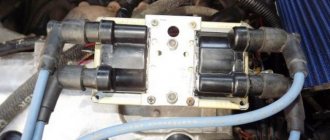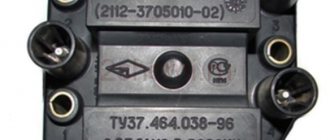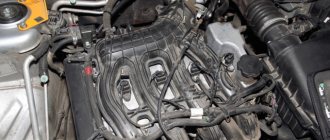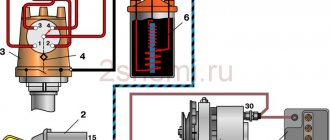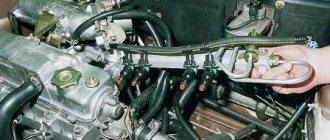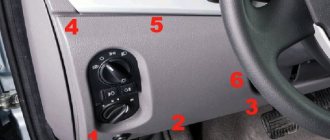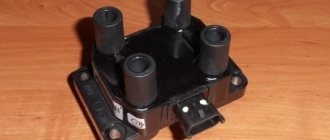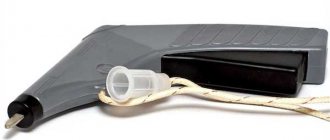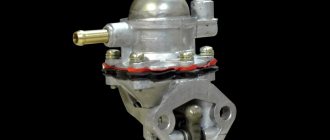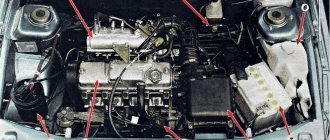VAZ 2112 engine ignition coil - this is the main part of the car’s ignition system, which serves as a conventional low-voltage direct current converter, which comes from the battery or directly from the electric generator into high-voltage voltage for further supplying an electrical impulse to the spark plugs.
In today's article we will learn how to check the ignition module on an injection VAZ-2112 8 valve with our own hands, and also consider step-by-step instructions for replacing this car unit.
Purpose and design of the ignition coil of the VAZ 2112
To create a pulse (spark) between the electrodes of the spark plug of the VAZ 2112 carburetor engine, a “standard”, classic or case coil was used for a non-contact ignition system (BSI), which is a high-voltage pulse step-up transformer with an open or closed magnetic circuit. Its use on “two-wheelers” continued until it was replaced by a two-spark (four-terminal) ignition coil (module) for 8-valve injection engines and an individual coil for power units with 16 valves.
New ignition coil for VAZ 2112
Diagnostics of malfunctions of the VAZ 2112 housing ignition coil for BSZ, nomenclature number 3122.3705 or 8352.12, consists of measuring the resistance of its primary and secondary windings and comparing the obtained data with table values. The resistance of the primary winding of coil 3122.3705 should be 0.43 (±0.04) Ohm, the secondary winding - 4.08 (±0.4) kOhm. The resistance of the coil 8352.12 is respectively 0.42 (±0.05) Ohm and 5 (±1) kOhm. The insulation resistance to ground must be at least 50 MOhm.
If measurement results differ by more than tolerance values, the coil must be replaced. You need the VAZ 2112 ignition coil, with its relatively low price, it is quite reliable and its replacement is rather an exception to the rule.
Ignition module VAZ 2112
The ignition module (four-terminal coil) provides simultaneous sparking in two cylinders (the first and fourth or the second and third). It needs to be checked for serviceability if there is no spark on one or more spark plugs. It is checked using a stand that simulates various engine operating modes and an oscilloscope. Checking “in the field” consists of connecting a known working spark plug one by one to the tips of high-voltage wires, grounding it to ground and, turning the crankshaft with the starter, visually detecting spark formation on the electrodes of the “test” spark plug.
Symptoms of module malfunction
Signs of a faulty ignition module on a VAZ-2110 are always acutely felt:
- hesitant engine starting or failure to start;
- failures during sudden changes in speed;
- high fuel consumption;
- two cylinders do not work, the engine is feverish;
- lack of dynamics;
- a sharp drop in power;
- drop in power and thrust after warming up.
Other faults
We unscrew and look at the spark plugs. Checking the high voltage wires.
These symptoms may not only be caused by the ignition module. To determine the malfunction, it is enough to spend a few minutes diagnosing spark plugs, high-voltage wires and caps. This will eliminate the remaining elements of the ignition system and make sure that it is the ignition module that is faulty.
- Checking the spark plugs . To do this, unscrew them, put on the caps, place them on the cylinder head and crank the engine with the starter. The spark should be stable on all spark plugs. We replace non-working spark plugs and repeat the test. Under no circumstances should you crank the engine with the starter with the high-voltage wires removed. This will lead to a breakdown in the ignition module cover.
- Checking the high voltage wires . We remove the caps and hold the wire contact through the insulator at a distance of 10-15 mm from the head . With good wires, the spark should pierce this distance vigorously and confidently. Next we check the wires for resistance. A working wire should have a nominal resistance of 7-10 kOhm. Any deviation from this value indicates the need to replace the entire set of high-voltage wires.
- We check the caps for breakdown .
We also look at the block and especially the wires included in it.
If all these elements are in good condition, the ignition module must be checked.
In addition, it is better to check the spark plugs and wires on a warm engine, since a half-dead ignition module can operate cold for some time and fail when heated. You also need to be sure that all sensors are working properly. This can be indicated by an error code or Check Engine light.
Algorithm for checking the ignition module on a VAZ-2110
We begin the test with the block connected to the module.
To check the module, we only need a multimeter and it will take 15-20 . This is quite simple to do, the main thing is to adhere to the algorithm and know the nominal values of the working module:
- We check the power supply and the presence of pulses supplied from the ECU . We check the power between the central terminal (15) of the wire block connected to the module and the engine ground. When the ignition is on, the voltage should not be less than 12 V. Otherwise, either the battery is dead or the ECU does not work.
- We check the pulses from the ECU on the wiring block . We install one tester probe on connector 15, the second on the far right, then on the far left. The assistant cranks the engine with the starter, and at this time we record short-term voltage surges with a tester. If there are no impulses from the ECU, it is he who is to blame.
- We check the resistance on the secondary windings of the coils . We put the tester in resistance measurement mode and measure it at the high-voltage terminals of the module cover. Between pins 1 and 4 and pins 2-3, the resistance should be 5.4 kOhm. Otherwise, the module must be replaced.
- We check the resistance of the primary windings between contacts 15 and the rightmost, then the leftmost terminals. Nominal - 0.5 Ohm . Deviation is not allowed.
- Check the module for a short circuit . In ohmmeter mode, install one multimeter probe on the central terminal, the second on the metal body. There shouldn't be any resistance. If the device detects at least some resistance (other than unity or infinity), the module must be replaced.
Version of the module on the 8-valve VAZ-2112
Two 8-valve engines of different volumes were installed on the twelve-wheeler - 1.5 and 1.6 liters. The ignition modules for these engines are different. The one and a half liter engine has a module with article number 2112-3705010, and the 1600 cc engine is equipped with a module 2111-3705010. A module for a 1.5 liter engine costs about 1500-2100, and the second one is 500 rubles cheaper.
Which is better?
SOATE devices manufactured in Stary Oskol have proven themselves to be the most reliable ignition modules.
Module structure
It consists of two ignition coils and two high-voltage switch switches. The coils are designed to create high-voltage pulses.
In essence, it is a simple transformer that has two windings: a primary winding, with an induction voltage of approximately five hundred Volts, and a secondary winding, with an inductive voltage of at least twenty kiloVolts. Everything is placed in one housing with one connector for signal wires and four for high-voltage.
Structure of the ignition coil module of the VAZ 2112
The operation of the ignition module is based on the “idle spark principle”. The module is capable of distributing a spark in pairs: to the first and fourth, second and third cylinders when transmitting pulses from the electronic control unit.
Design of the ignition module of a 16-valve engine on a VAZ-2110
Despite the similarity in engine design, the ignition system of the 1.5-liter injection 16-valve engine differs from the 1.6 16-valve engine. The 1.6 liter engine uses an electronic contactless ignition system with individual coils on each spark plug. Therefore, there was no need for an ignition module. Such a system is more reliable and cheaper to operate, since if one coil fails, there is no need to replace the entire module.
This is the coil that sits on each spark plug of a 1.6 liter engine.
Features and articles
The 16-valve 1.5-liter VAZ 2112 injection engine used the same non-contact ignition system as the eight-valve engine, but a different ignition module was installed.
Its catalog number is 2112-3705010 , and they sell it for 2000-3000 rubles , depending on the manufacturer. The design of the module remains the same - two ignition coils (for cylinders 1-4 and 2-3) plus switch keys in a single block. The spark is supplied to the cylinders in pairs using the idle spark method. This means that sparking occurs in two cylinders simultaneously - in one on the compression stroke (working spark), in the second on the exhaust stroke (idle spark).
Ignition module for 16-valve 1.5 liter engine.
Malfunctions of ignition modules on VAZ-2112
The process of removing the ignition coil on a VAZ 2112
If the VAZ 2112 engine starts running intermittently or does not start at all, the cause of the problem may be the ignition module.
Characteristic symptoms of a malfunction of the ignition module of the VAZ 2110:
- insufficient engine power,
- when accelerating the car jerks,
- either 1 and 4 or 2 and 3 do not work at the same time,
- the engine does not start.
It should be noted that on the VAZ-2112 one of the coils is responsible for the operation of cylinders 1 and 4, the second - for cylinders 2 and 3. If one ignition coil fails inside the monolithic block, two cylinders stop working at once.
To eliminate all other components of the ignition system, make sure that the spark plugs are in working order.
Installation of a new ignition module for VAZ 2112
To do this, unscrew them and check the spark on each of the spark plugs by cranking the engine with the starter and placing the spark plug with the high-voltage wire on the head so that the body (threaded part) of the spark plug touches the engine mass.
If there is no spark or it is weak, replace the spark plug with one that is known to work. If this does not lead to anything, check the high-voltage wires.
Thus, we will exclude spark plugs, caps and high-voltage wires from the list of non-working elements. Next we will check the ignition module.
Description of the ignition module
Before we talk about testing and replacing the MZ in our VAZ 2111, let's understand the basic information. To begin with, we suggest finding out what the 2111 ignition module is and where it is located.
Purpose and location
As mentioned above, the MZ is one of the main devices in the ignition system. Of course, if you think about it, all the components of the system are very important, since the quality of operation of the power unit as a whole depends on them. But if this unit begins to work intermittently, then at least two cylinders in the engine will stop working, or even all four. This is due to the fact that the module itself consists of two coils, with one of them supplying current to the first and fourth cylinders, and the second to the second and third. Accordingly, if one coil fails, this will lead to two cylinders being inoperative, which will affect the operation of the engine as a whole.
The purpose of this device is that it converts the voltage supplied from the interrupter device into a high-voltage signal. This impulse, accordingly, is supplied to the cylinder spark plugs in a certain order. It is used to ignite the combustible mixture in the engine cylinders, which facilitates its normal starting and operation.
Lada twelfth model
As for the location, it is not difficult to find the ignition module for the VAZ 2112 16 valves; it is located in the engine compartment. Open the hood and look at the spark plugs - they are connected to high-voltage wires that go directly from the module itself. The MZ itself is a small black square box, so you won’t be able to confuse it with anything else.
Common faults
Only diagnostics will allow you to accurately determine the malfunction of the module, but there are indirect signs that can inform the car owner about a problem in the operation of the device.
If the MZ malfunctions, an error light appears on the dashboard.
So, in what cases is it necessary to replace or repair the VAZ ignition module:
- Starting the power unit has become more difficult. Now the driver needs to turn the starter more to start the engine.
- Engine idling has become unstable. The engine may rev, and the speed may rise and fall.
- The power of the power unit as a whole has decreased. When you press the gas pedal, the car takes longer to accelerate. This symptom is especially obvious when driving uphill. Also, when pressing the gas pedal, dips may be observed - the driver presses the gas, but there is no effect.
- Fuel consumption has increased. Of course, without a fuel consumption meter, it will be difficult to determine such a malfunction. But if you are used to refueling a certain amount of fuel for a certain mileage, you will also be able to recognize this sign (the author of the video is the Auto_Remont channel).
All these symptoms, as stated above, are indirect, since they can also appear with other malfunctions. For example, if the fuel filter is clogged or its service life has come to an end. Also, such signs appear as a result of wear of the spark plugs or high-voltage wires. Therefore, if you are faced with such a problem, then first of all you should diagnose the condition of the spark plugs, make sure that there is no carbon deposits on them, and also check the armored wires. It happens that one of the wires is simply poorly connected to the spark plug, or it is broken or worn out.
Removing and replacing the ignition coil
In order to replace the module (ignition coil) on a VAZ 2112, you must perform the following steps:
- Before starting work, be sure to disconnect the battery by disconnecting the “-” terminal from it. (How to de-energize a battery.
- Then, approaching the ignition coil, disconnect one single high-voltage wire from its central part.
- Next, use a wrench to remove the two side nuts that hold the ends of the wires in place on the side of the coil.
- Next, when the nuts are unscrewed, remove both side wires from the coil.
- And to complete the operation, unscrew the two side nuts securing the ignition coil itself to the bracket.
- And then remove the coil from the car engine.
Ignition coil device
It is known that on 8-valve engines an ignition module was used (module repair, diagnostics) with two channels and coils that are capable of transmitting a spark to a pair of spark plugs at once. However, on a 16-valve engine, the coils became individual for each spark plug.
Prices and articles
The ignition coil from the Russian manufacturer SOATE for the VAZ-2112 has article number 2112-3705010-12 and costs around 1,000 rubles . Analogs from Bosch can cost twice as much, but the quality of these parts is much higher. In any case, the choice is always yours.
Ignition coil from Bosch.
Do-it-yourself installation of the VAZ 2112 ignition module
- Having picked up the new coil, first install it in its place by tightening the two nuts that secure it.
- Then place two wires on the sides of the coil and secure them with retaining nuts.
- When installing two side wires, pay attention to the markings that are marked on the sides of the ignition coil (see photo below). So this marking indicates which terminal of the coil should be connected to this or that wire. The blue wire must be connected to the “B” marking, and the red wire must be connected to the “K” marking!
- Then place the high-voltage wire on the central part of the ignition coil.
- And then install the negative terminal on the battery.
On old ignition coils, as a rule, instead of the letters “B” and “K”, the designations “-” and “+” are used, which means the same thing, but only in signs. The blue wire must be connected to the “-” sign, and the red wire must be connected to the “+” sign!
Diagnostics and repair of the ignition module on VAZ eleventh and twelfth models
In any car, including the VAZ 2112, the ignition module performs one of the main functions in the ignition system (IS) as a whole. Thanks to this unit, the engine starts optimally, as well as its normal operation in the future. You can learn more about device malfunctions, as well as its replacement, from this material.
Before we talk about testing and replacing the MZ in our VAZ 2111, let's understand the basic information. To begin with, we suggest finding out what the 2111 ignition module is and where it is located.
Purpose and location
As mentioned above, the MZ is one of the main devices in the ignition system. Of course, if you think about it, all the components of the system are very important, since the quality of operation of the power unit as a whole depends on them. But if this unit begins to work intermittently, then at least two cylinders in the engine will stop working, or even all four. This is due to the fact that the module itself consists of two coils, with one of them supplying current to the first and fourth cylinders, and the second to the second and third. Accordingly, if one coil fails, this will lead to two cylinders being inoperative, which will affect the operation of the engine as a whole.
The purpose of this device is that it converts the voltage supplied from the interrupter device into a high-voltage signal. This impulse, accordingly, is supplied to the cylinder spark plugs in a certain order. It is used to ignite the combustible mixture in the engine cylinders, which facilitates its normal starting and operation.
Lada twelfth model
As for the location, it is not difficult to find the ignition module for the VAZ 2112 16 valves; it is located in the engine compartment. Open the hood and look at the spark plugs - they are connected to high-voltage wires that go directly from the module itself. The MZ itself is a small black square box, so you won’t be able to confuse it with anything else.
Common faults
Only diagnostics will allow you to accurately determine the malfunction of the module, but there are indirect signs that can inform the car owner about a problem in the operation of the device.
If the MZ malfunctions, an error light appears on the dashboard.
So, in what cases is it necessary to replace or repair the VAZ ignition module:
- Starting the power unit has become more difficult. Now the driver needs to turn the starter more to start the engine.
- Engine idling has become unstable. The engine may rev, and the speed may rise and fall.
- The power of the power unit as a whole has decreased. When you press the gas pedal, the car takes longer to accelerate. This symptom is especially obvious when driving uphill. Also, when pressing the gas pedal, dips may be observed - the driver presses the gas, but there is no effect.
- Fuel consumption has increased. Of course, without a fuel consumption meter, it will be difficult to determine such a malfunction. But if you are used to refueling a certain amount of fuel for a certain mileage, you will also be able to recognize this sign (the author of the video is the Auto_Remont channel).
All these symptoms, as stated above, are indirect, since they can also appear with other malfunctions. For example, if the fuel filter is clogged or its service life has come to an end. Also, such signs appear as a result of wear of the spark plugs or high-voltage wires. Therefore, if you are faced with such a problem, then first of all you should diagnose the condition of the spark plugs, make sure that there is no carbon deposits on them, and also check the armored wires. It happens that one of the wires is simply poorly connected to the spark plug, or it is broken or worn out.
Checking the Ministry of Health with your own hands
There are several options for checking the device yourself at home; let’s look at the simplest one.
To carry out independent diagnostics, you need to know what the wires connected to the module are responsible for:
- Red-blue. A wire of this color provides 12-volt power to the device.
- The brown wire is ground and is usually connected to the car body.
- White-blue - connects to the spark plugs of the first and fourth cylinders.
- The red-gray wire connects to the spark plugs of the second and third cylinders.
Diagram of the VAZ module
First, you need to check with your own hands that all pulses are supplied to the ignition device 2112:
- First of all, you need to turn off the ignition and disconnect the connector.
- Next, the key in the lock must be moved to position I.
- Now you will need a dial voltmeter; it must be connected to the negative terminal of the battery.
- With the second probe, that is, the plus one, you need to find the 12-volt contact on the connector.
- When connected to the control contact, the arrow on the tester will show almost 0.
- If the starter unit starts working, the parameters may increase, but they will not exceed 0.7 volts. Please note that the voltage level at both control contacts must be identical.
There is another test option - you can diagnose the functionality of the module using a pointer ohmmeter. In this case, we mean a pointer tester, not a digital one. First you need to connect the probes of the device to pins 1 and 4 of the module, and after that to pins 2 and 3. Ultimately, the diagnostics should show the same result.
Please note that depending on the manufacturer, these parameters may differ:
- for devices manufactured by ATE-2 with number 3705010-02, this parameter should be about 5-6 kOhm;
- for SOATE modules with number 3705010-12, diagnostics should show 12 kOhm.
If the obtained indicators differ from those described above, then the module must be replaced. Please note that the inductance of the coils installed inside the MZ is quite high, therefore, connecting an ohmmeter, a spark may slip. Therefore, during diagnostics, we strongly do not recommend touching the probe leads at the same time (the author of the video is Evgeniy Popov).
Instructions for replacing the module
If checking the VAZ 2112 ignition module showed that the device needs to be replaced, then you can change the ignition module yourself.
The replacement process looks like this:
- Initially, you should turn off the power to the on-board network; to do this, you just need to disconnect the negative terminal from the battery. Many car enthusiasts neglect this step, although in fact it is very important. If you do not disconnect the battery, a short circuit may occur as a result of moisture or other external influences during repairs. And if this happens, then there is a chance that you will have to completely change the wiring in the car. So, to reset the battery terminal, you just need to unscrew the bolt that secures it with a wrench.
- Having done this, you will need to disconnect all high-voltage wires connected to it from the module. At the same time, you need to remember their location so that during installation you do not accidentally confuse them, which, again, can be fraught with danger for the entire system as a whole.
- After completing these steps, you will need to disconnect the connector with wires from the device itself. To do this, grab the block with your hand and press the latch with which it is attached - the fastener is located at the bottom, you can feel it with your hand. Having done this, you will need to remove the block and put it aside so that it does not interfere with you in the future.
- So, now you have two options - remove the device together with the mount or remove it separately. The first option is usually relevant in cases where, in addition to replacing the MZ, you need to perform other repair actions, for example, to get to the antifreeze drain hole of their cylinder block. Of course, it will be more convenient to dismantle the module separately, but then access to other parts and elements will be blocked. To dismantle you will need to unscrew the nuts with your own hands that secure the device to the bracket. Depending on the car, the nuts can be different; for example, they can be made in the form of hexagonal studs. If so, you will need a hex wrench to unscrew them. In any case, after unscrewing the nuts, it is necessary to dismantle the module from the seat.
- The procedure for installing a new module is carried out in a similar way, only in reverse order. When connecting with your own hands, be careful and be sure to correctly connect all the wires that connect to the module from the spark plugs. If at this stage you mix up the cylinder numbers on the high-voltage cables, the power unit may not work correctly or may not start at all.
Photo gallery “Replacing the MZ with your own hands”
1. Disconnect the wires from the MZ. 2. Disconnect the power plug. 3. Unscrew the nuts and dismantle the MZ.
Price issue
The cost of the device directly depends on the manufacturer. For example, the price for a new MZ from the manufacturer SOATE is about 1,700 rubles. A module from the manufacturer BOSCH will cost around 2 thousand rubles, and from General Motors - about 5 thousand rubles.
Video “Recommendations for diagnosing MH”
Important recommendations and features of diagnosing MZ in VAZ 2112 cars are shown in the video below (author - AutoElectrika Diary channel).
AvtoZam.com
Refinement of the VAZ ignition module, improving the spark
Rating 4.2 out of 5. Votes: 59
The standard ignition module of the VAZ 2110 copes with its duties, but not very well. The fact is that it holds the load, but is no longer able to withstand long-term operation at high speeds (4000-6000). Under such loads, the operation of the ignition module is unstable and, as a result, a poor spark. Is it possible to modify the ignition module? It will not be possible to modernize the standard ignition module (IM), but it is possible to manufacture a new, better ignition system to replace the standard one. It will produce a stable and strong spark under any engine load. You will need:
- Switch Astro 96.3734 - 2 pcs.
- Wiring to the switch - 1 piece
- Ignition coils (from VOLGA) 406.3705 - 2 pcs.
- Terminals "mother" - 4 pcs.
- High-voltage wires (from classics)
The first step is to modify the switches. We remove the transparent covers with a knife and unsolder the resistor - a jumper marked “0” from both switches. We assemble our tuning ignition module according to a diagram designed for a Bosch 7.0 ECU. (with other controllers, the wiring on the MZ plug may differ in color). The main thing when assembling the circuit is not to confuse “+” and “-” (as a rule, they are thicker than the others). We remove the standard ignition module and connect our device in its place. If the engine does not start, then swap the control wires on the coils! (see diagram). The resulting ignition system contributes to better starting of the car in winter, as well as improved driving characteristics. In addition, this system has increased reliability; heating does not deteriorate performance (as happens with a standard MZ). By the way, if you are completely satisfied with the standard MZ, but it is broken, then it can be repaired.
| Does it make sense to use such an improved car ignition system? |
Photo source:
- God's spark from the site bezzzumnyj.ru
Keywords:
Interesting site? Share with your friends
xn--2111-43da1a8c.xn--p1ai
